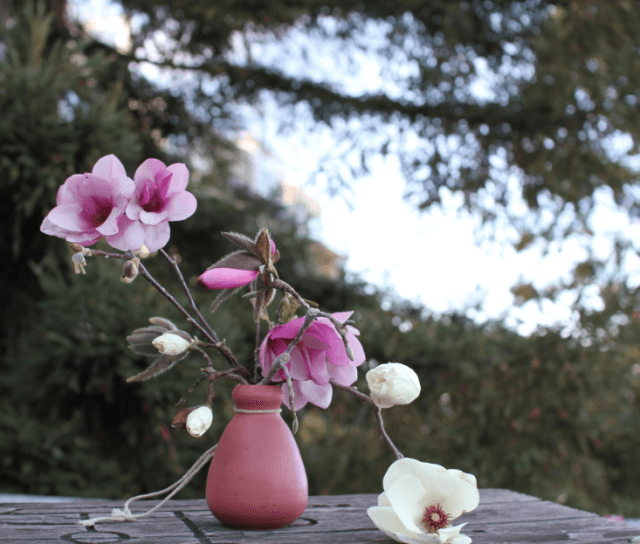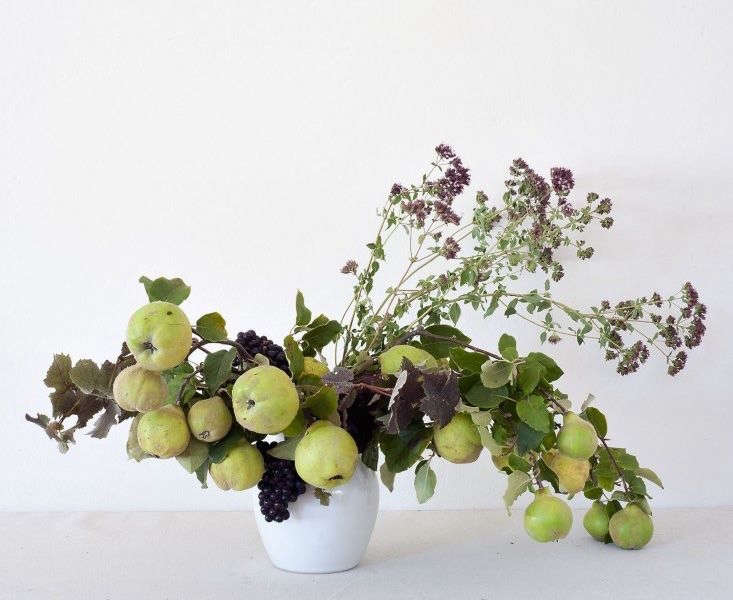In my family, foraging for DIY wedding flowers has become a tradition. It started when my mom had the idea to grow potted centerpieces for her big day. Great idea, but when the flowers arrived nothing was in bloom–hardly the “explosive fiesta of colors” my mother was after.
To save the day, Aunt Sheila and I headed to the local grocery store and bought as many sunflowers and dahlias as we could. Then, to give the arrangements more texture and a bit of local flavor, we headed into the woods to gather feathery goldenrod and stems of purple pokeberries. The results were bright, bold, and utterly unique. The cost of 14 centerpieces? A mere $100. But the best part was how much fun we had.
Today the foraged look is so popular that even the best professional floral designers are cultivating it. With outside-the-box greens such as grasses and vines or local and seasonal elements (fruit and berries), they conjure expressive, wild arrangements, evocative of both time and place.
Making your own foraged (or semi-foraged) wedding bouquet or centerpiece is easier than you think. Just follow some of these lessons from the experts.
N.B.: Featured image by Juliane Solvång via @onebouquetperday, from our story Instagram Bouquet-a-Day: A Self-Portrait in Flowers.
1. Keep it simple.

In this piece I will present a number of ways to create individual botanicals. But before you get carried away, I must stress one overriding principle. Edit, edit, edit. The reason professional florists are so adept at creating wild and woolly arrangements that don’t seem overgrown is because they set limits. It might be that they use a lot of texture, but a single shade, or maybe they create jewel-toned abundance with almost no greenery.
When in doubt as to the direction you want to take, it’s okay to gather many things. But after you get to the arranging table, cull.
2. Start with what’s in.

In season, that is. If lilacs are your thing but your wedding is in the fall, consider a centerpiece of crab apples instead. Winter weddings? Evergreens, pinecones, privet, or winter berries are lovely.
Of course, you don’t have to forage your whole bouquet. Specimens from the local florist or garden paired with wild greens mean you can still use your favorite blooms to wild effect.
And remember: don’t stress. Even if you carry nothing more than a single apple branch or a dewy bunch of ferns down the aisle, it will make a statement.
3. And add an element of surprise.

Be adventurous. Foraging for wedding florals is not just picking wild flowers. There’s a whole range of design elements outside your door. Consider the gnarled branch, the pine cone, feather, the reed, bunch of grass–even a piece of moss. If it fits the theme, it’s a go. Leafy branches, evergreens, vines, and berries, as we shall see, are great too. But remember, just one element of surprise. Too many will take your bouquet from unusual to unruly.
Below are some favorite surprising elements.
Sprays of Grass

Dutch garden designer Piet Oudulf has more than demonstrated the expressive splendor of grass. Abundant grasses are also easy and affecting in a foraged bouquet. They add texture and movement as well as a soft, airy quality that is perfect for weddings.
Merry Berries

Berries, like purple privet and juniper, are a wonderful way to add texture and a sense of place to your arrangement. Other favorites include raspberries (thorns removed); winter berry; honeysuckle (like privet, its shades range from bright green to aubergine); bittersweet (embrace an old enemy); rose hips, poke berries–even bay berries.
Sculptural Branches

Whether you use an abundance of saplings to create a forested feel or unloose your inner-ikebana with just one, solitary stick, branches really can make a statement at a wedding. Lash long cuttings together to create a wedding arbor. Lay them flat to create a centerpiece that runs the length of the table. Or add them to a bouquet to give it a dramatic, fresh-from-the-forest feel.
Festive Fruit

Nothing says seasonal like fruit still on the branches. For outdoor weddings, they’re also perfect for weighing down anything that might blow away.
Fragrant Herbs

Herbs from the garden not only add a savory element to your arrangement, they also have symbolic meaning. Rosemary represents remembrance, fidelity, and love. Sage: wisdom, virtue, and long life. Thyme stands for courage, while parsley symbolizes joy. Other favorites include lavender, dill, mustard flowers, mint, basiel, and feverfew.
Lovely Leaves

Even if your wedding is scheduled for prime flowering season, you’ll want to consider mixing foliage to your arrangements. They add texture and shape and can help fill out the look.
Fine Vines

My Aunt Sheila’s October wedding featured long tables laid together in a U-shape. For an easy, autumnal centerpiece that ran the entire length, we used winding, yellowing vines and purple honeysuckle berries, all foraged from the groom’s ancestral home by the sea. The takeaway: vines are just about the easiest, most versatile, and most economical wedding decoration there is. Not only can you lay them across the table, you also can drape them as easy garlands, encircle them to make a bridal wreath, even wind them around the cake.
Want more easy and foraged DIYs? See:
- Secrets from the Lost Kitchen: How to Arrange Flowers like a Self-Taught Maine Chef
- DIY: Foraging for a Midsummer Botanical Tabletop.
- Marry Me: 10 Tips to Plan a Simple Outdoor Wedding.
- Bride on A Budget: DIY Wedding Flowers for $20.












Have a Question or Comment About This Post?
Join the conversation (0)